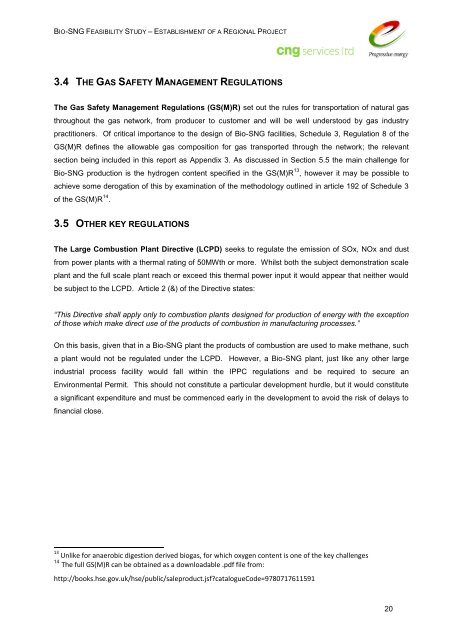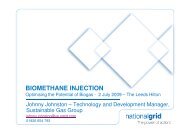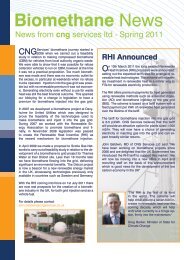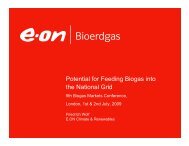Bio-SNG - CNG Services
Bio-SNG - CNG Services
Bio-SNG - CNG Services
You also want an ePaper? Increase the reach of your titles
YUMPU automatically turns print PDFs into web optimized ePapers that Google loves.
BIO-<strong>SNG</strong> FEASIBILITY STUDY – ESTABLISHMENT OF A REGIONAL PROJECT3.4 THE GAS SAFETY MANAGEMENT REGULATIONSThe Gas Safety Management Regulations (GS(M)R) set out the rules for transportation of natural gasthroughout the gas network, from producer to customer and will be well understood by gas industrypractitioners. Of critical importance to the design of <strong>Bio</strong>-<strong>SNG</strong> facilities, Schedule 3, Regulation 8 of theGS(M)R defines the allowable gas composition for gas transported through the network; the relevantsection being included in this report as Appendix 3. As discussed in Section 5.5 the main challenge for<strong>Bio</strong>-<strong>SNG</strong> production is the hydrogen content specified in the GS(M)R 13 , however it may be possible toachieve some derogation of this by examination of the methodology outlined in article 192 of Schedule 3of the GS(M)R 14 .3.5 OTHER KEY REGULATIONSThe Large Combustion Plant Directive (LCPD) seeks to regulate the emission of SOx, NOx and dustfrom power plants with a thermal rating of 50MWth or more. Whilst both the subject demonstration scaleplant and the full scale plant reach or exceed this thermal power input it would appear that neither wouldbe subject to the LCPD. Article 2 (&) of the Directive states:“This Directive shall apply only to combustion plants designed for production of energy with the exceptionof those which make direct use of the products of combustion in manufacturing processes.”On this basis, given that in a <strong>Bio</strong>-<strong>SNG</strong> plant the products of combustion are used to make methane, sucha plant would not be regulated under the LCPD. However, a <strong>Bio</strong>-<strong>SNG</strong> plant, just like any other largeindustrial process facility would fall within the IPPC regulations and be required to secure anEnvironmental Permit. This should not constitute a particular development hurdle, but it would constitutea significant expenditure and must be commenced early in the development to avoid the risk of delays tofinancial close.13 Unlike for anaerobic digestion derived biogas, for which oxygen content is one of the key challenges14 The full GS(M)R can be obtained as a downloadable .pdf file from:http://books.hse.gov.uk/hse/public/saleproduct.jsf?catalogueCode=978071761159120









